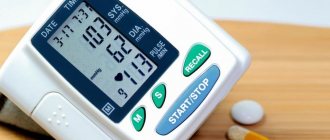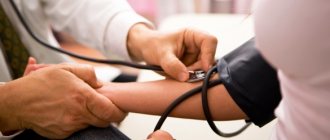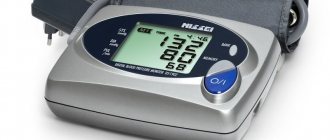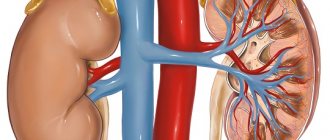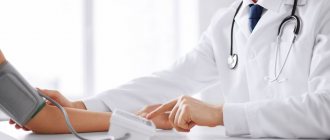Unfortunately, sudden changes in blood pressure are an unpleasant phenomenon that can first appear in a person at any age. The amount of blood pressure depends on the time of day, fatigue, what a person ate and drank, on his psychological and emotional state, and on weather conditions. And, if the problem of pressure surges has entered the system and become habitual, it is worth sounding the alarm and taking measures to stabilize the pressure.
For a healthy average person, a blood pressure of 120/80 is considered normal. However, for each specific person this figure is quite individual and can fluctuate within certain limits, being considered the norm, if, of course, the person feels cheerful and healthy.
If the pressure constantly fluctuates, this is definitely considered a deviation from the norm. Modern clinical research confirms that even a slight increase in blood pressure, if it occurs regularly, increases the likelihood of cerebral stroke and other serious diseases.
Medical certificate
The absence of problems with blood pressure is a sure sign of healthy functioning of the body. When natural mechanisms are disrupted, malfunctions occur, resulting in pressure surges. They have a much worse effect on the condition of the main organ systems than constant hypotension or hypertension. A change in readings even by 20% within one hour (for example, from 140/80 mm Hg to 160/100 mm Hg) is dangerous due to disruptions in the functioning of the brain and heart. This clinical picture indicates serious pathologies and can cause a heart attack or stroke.
Reasons for the sharp increase
The situation when blood pressure rises sharply is the most common in patients of any age. If blood pressure rises infrequently and is associated with external factors, the diagnosis of hypertension is not made. With a periodic increase in pressure above 140/90 mmHg, as well as in the presence of concomitant pathologies of the heart and blood vessels, the patient is registered with a cardiologist, and his condition is monitored by a specialist.
There are many reasons why normal blood pressure suddenly changes to high blood pressure. Most often they are associated with the influence of external factors, for example, physical activity. If a healthy person goes for a run, lifts a heavy object, or climbs stairs, the pressure may rise slightly. This situation is considered normal and is associated with increased blood flow and increased resistance of the vascular walls.
Serious emotional shocks, worries, and nervous breakdowns can also cause upward surges in blood pressure, so it is important to control your emotions and avoid reasons for worry. If this cannot be done for objective reasons (for example, when the work involves constant communication with different people and clarification of controversial situations), it makes sense to consult with a therapist, psychologist or neurologist about the possibility of using natural medicines with a sedative effect.
These include:
- "Tenoten";
- "Afobazole";
- "Valerian";
- "Motherwort";
- "Persen."
A sudden rise in blood pressure may be a reaction to certain medications. For example, during treatment with oral contraceptives containing estrogen, hypertension is one of the most common side effects. Almost all antibiotics, drugs for the systemic treatment of mycosis, and some drugs for restoring vision have the same effect.
Other reasons for increased blood pressure to 140/90 or higher include:
- change in climatic conditions (example: flying to countries with a climate opposite to the main place of residence);
- drinking large doses of alcohol (hangover syndrome);
- unfavorable weather conditions (magnetic storms, increased atmospheric pressure).
Important!
In the case of a temporary increase in blood pressure, a return to normal levels should occur within 30-40 minutes. If this does not happen, you should seek help from a doctor, as a sharp increase in pressure can cause a hypertensive crisis.
Normal blood pressure and possible deviations
| Normal or disease | Blood pressure readings |
| Norm | 120/80 mmHg |
| Minor deviation within the limits of normal health | 110-130/70-90 mmHg |
| Hypotension | ≤ 110/60 mmHg |
| Hypertension | ≥ 140/90 mmHg |
Pathological causes
Blood vessels are quite elastic and resilient and can cope with increased loads for a long period. Chronic diseases that have a direct impact on the functioning of the circulatory system can occur for a long time without obvious symptoms, but ultimately, the walls of the blood vessels no longer withstand the effects of adverse factors. Clinically, this is manifested by a sharp rise in pressure. In some situations, the pressure may rise so much that the patient will need emergency medical attention (figures of 160/100 mmHg are considered critical).
Pathological causes of a sudden increase in blood pressure include:
- diseases of the endocrine system;
- disorders of the kidneys, in which the renal system retains more moisture and blood thickening occurs;
- blockage of blood vessels with plaques consisting of excess cholesterol.
Important!
In men, sudden surges in pressure can be triggered by benign tumors consisting of glandular tissue (for example, prostate adenoma). In women, a sudden increase in blood pressure is typical for fibroids and uterine polyposis, as well as fibroadenomas - benign tumors of the mammary glands.
Physiology of normal pressure
During contraction of the left ventricle, blood from the heart enters the bloodstream. This is the systole phase. It provides systolic pressure. Then the myocardium relaxes or the diastole phase occurs. The pressure that blood vessels exert on the blood flow is called diastolic.
Normally, in a healthy person, fluctuations in systolic pressure are possible within the range of 100-140 mmHg. Art., and diastolic - 60-90 mm Hg. Art.
During the day, under the influence of various reasons (stress, overexertion, emotional outbursts), minor changes in blood pressure are likely. This is a completely normal reaction on the part of the body, which is thus trying to adapt to changing exogenous and endogenous factors. Allowable fluctuations in systolic pressure are 33 mmHg. Art., and diastolic - 10 mm Hg. Art. per day.
All the reasons why a person’s blood pressure fluctuates are usually divided into physiological and pathological. The first category includes weather changes, intense physical activity, cyclical hormonal changes, experiences and dietary features when a person consumes too much energy drinks or coffee. Against this background, pressure readings often shift upward to compensate for the organs’ needs for increased blood supply.
The pressure drops and rises
In healthy people, slight fluctuations throughout the day are considered normal. During night rest, blood pressure levels drop; during working hours, especially if the activity involves physically hard work, blood pressure may rise. If a person feels normal and deviations from the norm do not exceed acceptable levels, there is no need to worry. But in cases where the pressure jumps sharply, and this happens all the time, you need to consult a doctor and look for the cause. If this is not done, pre-infarction and stroke may develop.
Stress
One of the most common causes of pressure surges is stress. Most often, this situation is typical for young people who spend a lot of time at work or are constantly faced with difficult situations. An unfavorable psychological situation in the family also negatively affects the condition of blood vessels and can cause serious fluctuations. Recently experienced emotional shocks (divorce, death of a loved one, quarrel) can cause a persistent increase in blood pressure with subsequent wave-like jumps.
Important!
If you cannot cope with a stressful situation on your own, it is best to seek help from a qualified psychologist. If you have neurological abnormalities, a tendency to depression, neuroses and psychoses, you may need the help of a psychotherapist.
Obesity
Obesity is the main enemy of healthy blood vessels. Overweight people often eat poorly and consume large amounts of food high in fat and carbohydrates. Fats (especially animal fats) are deposited on the walls of blood vessels and form cholesterol plaques, which clog the internal space and interfere with the free flow of blood.
In obese patients, the pressure most often rises above the permissible values, but in some situations, jumps to the lower side are possible, after which an attack of hypertension occurs again.
Bad habits
In people who abuse alcohol and tobacco, pressure surges are a common occurrence. Toxic substances cause spasm of blood vessels. When the vascular walls expand, the pressure drops; when compression occurs, blood pressure readings begin to creep up.
Important!
Pressure changes in themselves are very dangerous for health, and if they occur against the background of chronic intoxication, the life prognosis becomes unfavorable and the risk of developing severe heart diseases increases: coronary artery disease, heart attack, rheumatism, etc.
Vegetative-vascular disorders
VSD is a complex of neurological symptoms that arise from pathologies of the autonomic nervous system. Clinically, vegetative-vascular dystonia is manifested by the following symptoms:
- headache;
- migraine attacks;
- nausea not associated with food intake;
- mood swings;
- pressure surges;
- compression and squeezing in the chest area.
Note!
There is no specific treatment for vegetative-vascular disorders. Therapy is aimed at eliminating the symptoms of VSD and correcting the lifestyle that the patient leads. A person with signs of VSD should spend more time in the fresh air, include many foods with a high content of vitamins in their diet, stop smoking and drinking alcoholic beverages, and increase physical activity (taking into account possible contraindications and restrictions).
Video - Why does pressure fluctuate?
Osteochondrosis and diseases of the cervical spine
Dystrophic disorders in the cartilage tissue of the joints of the cervical vertebrae are diagnosed in almost every third person. The development of pathology is facilitated by a sedentary lifestyle, chronic diseases of the endocrine and nervous systems, and abundant nutrition. With osteochondrosis of the cervical spine, compression of blood vessels and nerve endings occurs, which causes sharp fluctuations in pressure.
To get rid of unpleasant symptoms and improve your well-being, it is necessary to perform a set of therapeutic exercises selected by a doctor and treat all diseases and injuries of the spine in a timely manner. In some cases, drug correction with drugs based on lidocaine (for severe pain) and B vitamins can help.
If a patient experiences pressure surges, he should be registered with a local cardiologist, since such fluctuations can lead to serious complications from the cardiovascular system. In cases where a patient is prescribed drugs to treat hypotension or hypertension, the recommended dosage must be strictly followed. If the prescribed treatment does not bring the expected result, you should consult a doctor, but do not make changes to the treatment regimen yourself.
Pathological causes of surges
Instability of atmospheric pressure entails instability of arterial pressure. The so-called weather-dependent people are at risk. They always react to changes in climate or weather. Pathological causes of blood pressure surges can also be diseases of internal organs or hormonal disorders:
- Vegetative-vascular dystonia. The disorder most often occurs in women aged 16 to 35 years.
- Pathologies of the myocardium, entailing the loss of its full contractility (cardiac ischemia, angina pectoris and rest).
- Impaired functioning of the kidneys and urinary system (pyelonephritis, renal failure, nephropathy).
- Encephalopathy, brain tumors of various origins.
- Cerebrovascular accident. Usually we have to talk about pressure surges with cervical osteochondrosis, compression of the arteries feeding the cerebral structures.
- Hormonal imbalance caused by pathologies of the thyroid gland and adrenal glands.
- Uncontrolled use of certain medications (Bisoprolol, Anaprilin, Concor).
During any pathology, several stages are distinguished from the list. However, pressure instability usually occurs as the disease begins to progress. In rare cases, surges in blood pressure accompany the manifestation of the disease.
In women and men
Fluctuations in blood pressure in the fair sex can be caused by the onset of menstruation. This condition is not a pathology and involves hypotension due to physiological blood loss. No specific therapy is required.
Pregnancy is another reason why blood pressure fluctuates (either high or low). Changes occur in the body at the hormonal level, the nature of nutrition, toxicosis, and the experiences of the expectant mother. In the first months of gestation, blood pressure is usually low. If you feel normal, it should not cause concern.
When menopause occurs, the body experiences extreme stress. Serious hormonal changes occur, the amount of estrogen decreases. Vessels lose collagen, which gives them elasticity. While adaptation to the new state continues, blood pressure may fluctuate.
Instability of blood pressure readings in men is rare.
However, compared to women, they take less care of their health and rarely follow the rules of a balanced diet. They drink alcohol and smoke much more often. The listed factors negatively affect pressure indicators, causing sudden jumps.
In old age
Today, both teenagers and elderly patients complain of pressure surges. In the first case, health problems are usually caused by hormonal changes in the body, and a corresponding comprehensive examination of the child proves this. If during the diagnosis no significant health problems are identified, most likely he will “outgrow” the instability of pressure. As the body ages, older people often experience increased blood pressure, which needs to be controlled, including with medication.
Some of them take pills irregularly and do not follow the regimen. As a result, the pressure constantly fluctuates. Another reason for this pathology is self-medication. Many older patients violate the dosage of the prescribed drug or change the drug without permission. As a result, an elderly person’s blood pressure increases, he ignores the symptoms and does not consult a doctor. This is very dangerous due to the risk of vascular accident.
What needs to be examined?
It is necessary to examine several organs and systems at once.
The help of several specialized specialists is required: an endocrinologist, a cardiologist, a nephrologist (a doctor who deals with problems of the excretory system, including the kidneys), and a neurologist.
The list of studies is standard, aimed at assessing the main structures:
- Collecting anamnesis and oral examination of the patient regarding complaints, lifestyle, bad habits and other characteristic points.
- Study of blood hormone levels: T3, T4, TSH, cortisol. An important diagnostic element.
- Study of blood pressure levels in both arms.
- Using a Holter 24-hour monitor to assess blood pressure readings over a 24-hour period. This is something of a gold standard for early screening.
- General and biochemical blood test.
- Electrocardiography and encephalography. Necessary diagnostic measures. In the competent hands of a qualified medical specialist, these are extremely informative examinations.
- Angiography and/or Dopplerography of vessels of various locations.
In the system, this is quite enough to make and verify a diagnosis.
How to recognize pressure surges?
A variety of factors can lead to pressure surges. Therefore, it is necessary to be careful about your own health. People who have already encountered this problem note the appearance of characteristic symptoms:
- change in complexion (from white to reddish);
- weakness throughout the body;
- tremor of the limbs;
- feeling of lack of air;
- the appearance of vomiting, nausea;
- pain in the heart area;
- fainting;
- increased heart rate.
Dizziness and headaches, shortness of breath, blurred vision - these and the symptoms presented above signal health problems. In this case, it is necessary to immediately measure the pressure. During the procedure, the hand should remain calm. It is recommended to measure indicators every 20 minutes for two hours. If this situation repeats, you need to consult a doctor to examine the body for pressure surges, the reasons for either high or low readings.
Symptoms of pathology
Jumps in blood pressure are accompanied by characteristic symptoms, and if you take the medications prescribed by your doctor on time, you will be able to avoid a severe deterioration in your condition. The main symptom that is characteristic of sharply increasing and decreasing blood pressure is a severe headache. With high blood pressure, the pain is concentrated in the temporal part, and with low blood pressure, the back of the head hurts, and less often, discomfort is felt in the forehead area. In addition to pain, the patient feels dizzy, shows signs of indigestion, and also:
- vision and hearing are impaired;
- the skin becomes red or pale;
- dizziness and nausea are accompanied by bouts of vomiting;
- breathing becomes difficult;
- upper and lower limbs go numb;
- breaks out into a cold, then into a hot sweat;
- I am worried about severe chest pain.
Drug treatment is prescribed exclusively by a doctor.
When such symptoms develop, it is dangerous to try to cope with the problem yourself, and to avoid serious complications, it is better to call an ambulance. On the spot, the doctor will initially assess the extent of the problem, and if necessary, suggest hospitalization with a detailed examination that will help identify the causes of pressure surges. In the case where the attacks are periodic, and after taking medications the condition returns to normal, the doctor will prescribe a treatment regimen at home, as well as prescribe medications that can normalize the condition in a short time.
First aid for an attack
If a person’s blood pressure has increased or decreased significantly, the first thing to do is to calm him down. At such moments, a feeling of fear appears, which quickly develops into a panic attack. You should try to find out why the attack happened, eliminate the cause if possible and call a team of medical workers.
Before their arrival, you should open all the windows in the room, thereby ensuring an influx of fresh air. It is better to remove clothing from the upper part of the body so that it does not put pressure on the chest and does not interfere with breathing fully. Subsequently, all actions will depend on pressure indicators.
| Hypertension after lowering blood pressure | Hypotension after increased blood pressure |
| The person must be placed in a semi-sitting position. This will prevent blood from rushing to your head too quickly. | Place the victim in a horizontal position with his legs slightly elevated. To do this, place a pillow under your knees. |
| Give any pill for hypertension (for example, Anaprilin). | Give a Caffeine tablet to increase blood pressure. If medications are not available, they can be replaced with a cup of sweet coffee or a glass of salted water. |
| For pain in the heart, put Nitroglycerin under the tongue. |
During the provision of assistance, it is advisable to measure blood pressure every 15 minutes before the ambulance team arrives and record the readings in writing. Then they need to be handed over to doctors. This approach will allow specialists to immediately assess the clinical picture and take the necessary measures.
How to treat?
Treatment with medications
The tablet should not be swallowed whole.
If blood pressure has increased sharply, it is recommended to take a Captopril or Nifedipine tablet under the tongue, lie down in a comfortable position, and wait until the condition returns to normal. If after half an hour the medicine has not given any effect, you should take the medicine again. If the condition does not stabilize, the patient becomes worse, stop taking the medications and immediately call an ambulance. If the patient has become restless, you can take Corvalol, Barboval, or valerian.
They say that low blood pressure is safer than high blood pressure, but you should not ignore the problem, since even with extremely low blood pressure the situation can have serious consequences. If your blood pressure drops sharply, you should immediately drink a cup of sweet tea or coffee. You can take medications such as “Citramon”, “Pentalgin”, and in order for the pressure to return to normal, it is recommended to take courses of the homeopathic remedy “Tonginal”.
Which doctor should I contact?
Most people with hypotension know that at home they can normalize blood pressure using ginseng or eleutherococcus. In the case of hypertension, the situation is somewhat more complicated. Experts do not recommend folk remedies or self-medication due to the high likelihood of complications. Therefore, if there are regular pressure surges (either high or low), you need to consult a therapist and undergo examination by specialized specialists. These are a cardiologist, an ophthalmologist, a urologist, a neurologist and an endocrinologist.
To determine pressure surges, you should monitor the indicators over time - take measurements several times a day and record all the results.
The procedure itself is carried out at home, but more often 24-hour blood pressure monitoring is used during diagnosis. To do this, a cuff is placed on the patient's shoulder, and a special monitor is attached to a belt or lower back.
The device automatically saves the values at the right time. There is no need for a person to behave in a special way. He can do his usual activities and go to work. A systematic approach allows us to establish the presence of arterial hypertension and hidden pathologies of the cardiac system. Additionally, you may need to take a general blood test and hormone tests, do an EEG and ECG, and angiography of vessels of various locations. After determining the reason why the pressure fluctuates throughout the day, the physician will be able to select adequate therapy.
Causes of high blood pressure
High blood pressure is divided into 2 types:
- primary (essential) hypertension (or hypertension) is the most common type of high blood pressure, often has no cause, develops over many years, the risk increases with age;
- secondary hypertension occurs against the background of the development of any disease (kidneys, endocrine system organs, sleep apnea) or taking certain medications.
Causes of high blood pressure include:
- old age (the older a person is, the higher the likelihood of developing hypertension);
- family history of the disease (high blood pressure in parents or other close relatives);
- unhealthy diet - diet high in salt and fat;
- lack of physical activity;
- overweight, obesity;
- sleep disorders;
- chronic diseases (chronic kidney disease, endocrine disorders, diabetes, high cholesterol);
- race (eg, African Americans have a higher risk);
- gender (in middle age, high blood pressure develops more often in men, in old age - in women; women who had high blood pressure during pregnancy are more prone to arterial hypertension in old age);
- certain medications (contraceptives, decongestants, NSAIDs, antidepressants);
- stress;
- smoking;
- alcohol abuse;
- non-compliance with sleep schedule, night shift work.
High blood pressure is often called the “silent killer” due to its lack of noticeable symptoms. In some cases (especially when blood pressure levels reach dangerously high levels), a person may complain of headache, nosebleeds, and shortness of breath. Many people do not associate these symptoms with abnormal blood pressure readings because they are not in the habit of periodically monitoring their blood pressure with a doctor or at home.
Taking medications
Treating pressure changes requires a lot of time and effort. Therapy is carried out under the supervision of several specialists simultaneously and depends on the root cause of the disorder. Usually high blood pressure is treated, and low blood pressure is tried to be normalized using folk methods and lifestyle changes. If the disorder progresses against the background of vegetative-vascular dystonia, it is necessary to normalize the functioning of the nervous system. For this purpose, various sedatives are used (tincture of motherwort or valerian root, Glycine). For panic attacks, doctors prescribe tranquilizers and antidepressants.
In case of arterial hypertension, ACE inhibitors (Enalapril, Lisinopril), calcium channel blockers (Verapamil) are used. It is mandatory to take diuretics and beta blockers. There are also combined drugs for hypertension, for example, Andipal. It is important to understand that treatment with antihypertensive drugs is a long process. You should not suddenly stop taking medications, because this can provoke new pressure surges.
Non-drug methods for correcting the condition
An important component of complex treatment of the problem is non-drug treatment. Its goal is to minimize the risks of hypotension or hypertension. Supportive activities do not require significant financial costs and come down to the principles of a healthy lifestyle:
- Dosed physical activity, including in old age.
- Regular hardening through a contrast shower and dousing with cold water.
- A balanced diet while limiting excessively fatty and fried foods.
- Fractional meals (it is better to eat often, but in small portions).
- The diet should be dominated by fresh vegetables and fruits, fish, and a variety of cereals.
- Compliance with the work and rest regime. Daily night sleep should be about 8 hours.
- Elimination of all bad habits.
- Control of stress and psycho-emotional experiences.
In the case of a hereditary predisposition to hypertension or hypotension, it is important to regularly measure blood pressure. People over 50 years of age at risk need to take appropriate medications for preventive purposes. If pressure surges are regular, serious drug treatment is required.
Preventive measures
To prevent blood pressure surges, you must:
- Regularly monitor blood pressure using a home blood pressure monitor;
- Avoid coffee and strong tea;
- Minimize fat and salt content in food;
- Eliminate smoked meats, sausages, and canned food from the diet;
- Increase consumption of sea fish, vegetables and fruits;
- Do not give up physical activity, but it should be moderate (exercise, walking) so as not to strain the body;
- Get enough sleep at night and rest during the day;
- Maintain body weight at the same level;
- Do not take medications that quickly lower blood pressure, which can cause collapse due to rapid drainage of blood from the brain and lead to death (this recommendation is especially relevant for people over 90 years of age).
Traditional methods of treatment
As an additional measure to eliminate unstable blood pressure, you can use recipes from traditional healers. The main goal of such therapy is to strengthen the walls of blood vessels and increase their elasticity. Tinctures and decoctions prepared from medicinal herbs help cleanse arteries, prevent clogging, and improve the functioning of the heart and kidneys. As a result, normalization of blood pressure indicators is observed.
Rose hips contain a large amount of vitamins. They have a positive effect on the functioning of the heart and the state of the nervous system. It is better to brew rosehip in a thermos overnight, and drink it like regular tea in the morning. You can prepare a tincture based on these fruits. You will need to pour vodka into the rose hips in a ratio of 1:5. Take the composition 10 drops 2 times a day, after diluting it in a small amount of water.
Honey is useful for pressure surges, because it makes blood vessels more elastic and improves the overall composition of the blood. A small amount of it should be mixed with 2 tablespoons of aloe, 3 cloves of garlic and the juice of a whole lemon. The finished product should be stored in the refrigerator. Take a teaspoon of juice to cleanse blood vessels.

